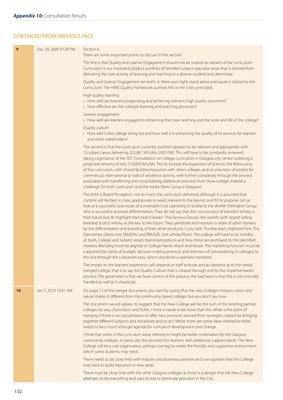
9 Dec 29, 2009 07:39 PM Section 6
There are some important points to discuss in this section.
The i rst is that Quality and Learner Engagement should not be treated as subsets of the curriculum.
Curriculum is our marketed product portfolio of branded subject specialist areas that is derived from
delivering the core activity of learning and teaching to a diverse student and client base.
Quality and Learner Engagement are both, in there own right, stand alone and equal in stature to the
curriculum. The HMIE Quality Framework outlines this in the 3 key principles:
High quality learning
How well are learners progressing and achieving relevant, high quality outcomes?
How ef ective are the college's learning and teaching processes?
Learner engagement
How well are learners engaged in enhancing their own learning and the work and life of the college?
Quality culture
How well is the college being led and how well is it enhancing the quality of its services for learners
and other stakeholders?
The second is that the curriculum currently outlined appears to be relevant and appropriate with
13 subject areas delivering 222,867 WSUMs (2007/08). This will have to be constantly reviewed
taking cognisance of the SFC 'Consultation on college curriculum in Glasgow city centre' outlining a
projected delivery of only 210,000 WSUMs. This to include the expansion of Science, the Refocusing
of the curriculum, with shared facilities/resources with other colleges, and no provision of estates for
commercial, international or halls of residence activity, with further complexity through the process
associated with transferring and consolidating additional provision from Stow college. Indeed a
challenge for both curriculum and the estate (New Campus Glasgow).
The third is Brand Perception, not so much the curriculum delivered, although it is assumed that
content will be best in class, appropriate to need, relevant to the learner, and i t for purpose. Let us
look at a successful case study of a charitable trust operating in Scotland, the distiller 'Edrington Group'
who is successful at brand dif erentiation. They do not say that the core product of blended whisky is
their future but do highlight their brand leader ' The Famous Grouse', the world's sixth largest selling
blended Scotch whisky as the key to the future. They penetrate and maintain a share of other markets
by the dif erentiation and branding of their other products: Cutty Sark; The Macallan; Highland Park; The
Glenrothes; Glenturret; TAMDHU and BRUGAL (not whisky/Rum). The college will have to be mindful
of, both, College and Subject area(s) brand perceptions and how these are portrayed to the identii ed
markets. Branding must be aligned to College Name; Vision and Values. The marketing function must be
supported by clarity of budget, decision making protocol, and direction of consolidating (3 colleges) to
the one through the customers eyes, which should be a seamless transition.
The impact to the learners' experience will depend on staf attitude and acceptance as to the newly
merged college, that is to say the Quality Culture that is created through and by the implementation
process. The good news is that we have control of this process; the bad news is that this is not normally
handled as well as it should be.
•
•
•
•
10 Jan 7, 2010 10:41 AM On page 12 of the merger document, you start by saying that the new College's mission, vision and
values makes it dif erent from the community based colleges but you don't say how.
The document would appear to suggest that the New College will be the sum of the exisiting partner
colleges by way of provision and SUMs. I think it needs to be more than this. What is the point of
merging if there is no consolidation of of er, new provision derived from synergies created by bringing
together dif erent subjects and disciplines and so on? Whilst there are some ideas referred to there
needs to be a much stronger agenda for currculum development and change.
I think that some of the currculum areas referred to might be better undertaken by the Glasgow
community colleges, in particular, the provision for learners with additional support needs. The New
College will be a vast organisation, perhaps too big to create the friendly and supportive environment
which some students may need.
There needs to be close links with industry and business partners and a recognition that the College
may have to build repuation in new areas.
There must be close links with the other Glasgow colleges as there is a danger that the New College
attempts to do everything and uses its size to dominate provision in the City.
CONTINUED FROM PREVIOUS PAGE
132
Appendix 10: Consultation Results